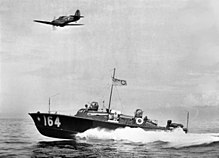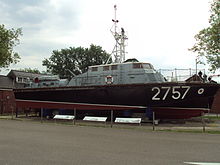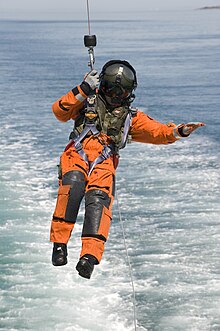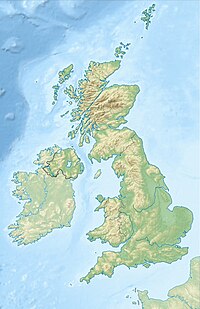|
RAF Search and Rescue Force
The Royal Air Force Search and Rescue Force (RAF SARF or RAF SAR Force) was a unit of the Royal Air Force (RAF) which provided around-the-clock aeronautical search and rescue cover in the United Kingdom, Cyprus, and the Falkland Islands, from 1986 until 2016. The Search and Rescue Force was established in 1986 from the helicopter elements of the RAF Marine Branch which was disbanded that year. The Force supported search and rescue over the United Kingdom until 4 October 2015 when the role was privatised, and civilian contractor Bristow Helicopters assumed the role on behalf of HM Coastguard. On 18 February 2016, the force's disbandment was officially marked with a parade in front of William, Duke of Cambridge, himself a former SAR pilot, and Catherine, Duchess of Cambridge, his wife.[1][2] History In 1918, the Royal Air Force was established through the merging of the aviation arms of the Royal Navy, the Royal Navy Air Service (RNAS), and that of the Army, the Royal Flying Corps. Together with its aircraft, vessels acquired to support RAF seaplane operations were also transferred to the new service,[3] becoming the Marine Craft Section (MCS).[3] Post-war, the Marine Craft Section became a force of 150 vessels, which in addition to supporting the operation of seaplanes, were equipped for rescue operations, with a launch being at the ready whenever an aircraft was flying over water.[3] However, the training and seamanship of the crews, especially with regards to navigation, meant that the MCS at this time was only suitable for inshore rescue operations.[3] As the vessels it had inherited from the Royal Navy began wear out, the RAF began to have built for launches capable of higher speeds, and in light of the larger crews of some aircraft, greater capacity. This would, in the late 1930s, lead to the acquiring of High Speed Launches (HSL) for rescue operations. However, during the Second World War, the Marine Craft Section found itself ill-prepared for war. During the Battle of Britain, even with the help of civilian vessels and the Royal Navy, aircrew who baled out or ditched in the North Sea and English Channel had only a 20 percent chance of being returned to their squadrons, with over 200 pilots and aircrew being lost to the sea during the battle.[3] An informal air-sea rescue was started in July 1940 by Flying Officer Russell Aitken, who with the approval of his senior officer at RAF Gosport, began flying a Supermarine Walrus to rescue pilots downed in the English Channel. By the end of August, when he ceased this work, he had rescued around 35 British and German aircrew.[4] In light of this, in 1941, an emergency meeting was convened by Air Marshal Sir Arthur 'Bomber' Harris. The Royal Navy offered to take over in its entirety the at sea rescue role, the RAF declined and subsequently created the Directorate of Air Sea Rescue on 6 February 1941, which adopted the motto 'The sea shall not have them'. Operationally, it was to become known as Air Sea Rescue Services (ASRS), which ultimately became the RAF Search and Rescue Force.[5] The headquarters of the ASRS was co-located with that of RAF Coastal Command with which it operated closely. Together with creation of specialist Air Sea Rescue Units (ASRU), ASRS worked to improve the survival of aircrews through the development and issue of better individual survival equipment, including one man inflatable dinghies for fighter pilots copied from the Germans; the training of aircrew in ditching drills to maximise their chances of surviving to be retrieved; the development and fielding of air droppable survival equipment; and coordination between the different services, branches and units towards the goal of locating and recovering of downed airmen.  The air-sea rescue squadrons of the ASRS flew a variety of aircraft, usually hand-me-downs rejected or withdrawn from front-line service by the RAF's other branches, or as in the case of the Walrus, begged from the Royal Navy.[6] They used Supermarine Spitfires and Boulton Paul Defiants to patrol for downed aircrew, and Avro Ansons to drop supplies and dinghies. Supermarine Walrus and Supermarine Sea Otter amphibious craft were used to pick up aircrew from the water.[7] Larger aircraft were used to drop airborne lifeboats. Although the Walrus and Sea Otters could pick up survivors close to shore and in coastal waters further out to sea, it was still not possible for aircraft to routinely pick up survivors, the large flying boats that could do so, such as the Consolidated Catalinas and Short Sunderlands of Coastal Command, had many other jobs to do and were not always available.[6] The role of aircraft in the ASRS therefore, was to locate downed airmen and to keep them alive, by dropping them survival equipment and stores, until an ASRS launch, or one from the Royal Navy's Naval Sea Rescue Services, arrived to pick them up.[6] Generally MCS craft had responsibility for the Channel and North Sea, and Royal Navy ones for the Western Approaches. By the end of the Second World War, more than 8,000 aircrew and 5,000 civilians had been rescued. At the end of the Second World War, the MCS had some 300 HSLs and over a thousand other vessels,[3] the largest fleet of such rescue craft in the world. This fleet and the RAF sailors that crewed it would contract as the RAF did, however it continued be found everywhere that the RAF flew over water. Introduction of helicoptersIn the mid 1950s, helicopters began to replace fixed-wing aircraft and supplement the marine craft in the search and rescue role, their ability to hover giving them an ability to recover survivors that fixed wing aircraft did not have. It was not until the 1960s, with the introduction of the Westland Whirlwind, the Westland Wessex, and later the Westland Sea King, that it was possible to replace marine craft in all sea and weather conditions. Helicopters have the advantage of speed, which means that the same coverage as marine craft can be provided with far fewer bases and much reduced personnel numbers. However, even into the 1970s, helicopters had not completely replaced RAF marine craft, however by this time the MCS craft were becoming increasingly elderly and service in the MCS increasingly unattractive. In 1986, the Marine Branch was disbanded, the last of the RAF's vessels were retired. Henceforth the RAF's rescue operations would be entirely helicopter based, Air Sea Rescue Services would be renamed the RAF Search and Rescue Force. Role The SARF's primary roles were military search and rescue, and the provision of rescue for civilian aircraft in distress under the 1948 Chicago Convention. The latter was a delegated responsibility to the UK Ministry of Defence (MoD) from the Department of Transport, who had primary responsibility for general search and rescue of any type throughout the UK Search and Rescue Region (UK SRR). The military role involved the rescuing of aircrew who have ejected or parachuted from, or crash-landed their aircraft. This role raises the wartime combat effectiveness of the RAF (and RN) by enabling downed aircrew to be returned to front-line flying duties as soon as possible. Although established with a primary role of military search and rescue, most of SARF's operational missions were spent in its secondary role, conducting civil search and rescue. This entails the rescue of civilians from the sea, on mountains, from flooded regions or other locations on land. The aeronautical search and rescue roles were complemented by the related Royal Air Force Mountain Rescue Service, whose trained mountaineers also conduct search and rescue in hilly terrain. SARF helicopters and RAF mountaineers often work together on mountain rescue incidents. The military and civil roles were shared with the Sea King helicopters of the Royal Navy's Fleet Air Arm, while the civil search and rescue role was also shared with the helicopters of HM Coastguard. OrganisationSearch and Rescue Helicopter Wing The wing was formed at RAF Finningley on 1 September 1976, it was disbanded on 1 December 1992.[8] Search and Rescue Training Unit The Search and Rescue Training Unit was formed on 3 December 1979 at RAF Valley.[8] No. 22 Squadron RAF15 February 1955 to June 1955 - HQ at RAF Thorney Island
June 1955 to June 1956 - HQ at RAF Thorney Island
June 1956 to April 1974 - HQ at RAF St Mawgan
April 1974 to January 1976 - HQ at RAF Thorney Island
January 1976 to June 1976 - HQ at RAF Finningley
 June 1976 to December 1992[11] - HQ at RAF Finningley
December 1992 to September 1997 - HQ at RAF St Mawgan[11]
September 1997 to unknown - HQ at RMB Chivenor[10]
Unknown to October 2015 - HQ at RAF Valley
No. 110 Squadron RAF3 June 1959 to 15 February 1971 - HQ at RAF Kuala Lumpur
No. 202 Squadron RAF August 1964 to September 1976 - HQ at RAF Leconfield
September 1976 to 1 December 1992[19] - HQ at RAF Finningley
1 December 1992[19] to April 2008 - HQ at RAF Boulmer
April 2008 to October 2015 - HQ at RAF Valley
No. 228 Squadron RAFSeptember 1959 to August 1964 - HQ at RAF Leconfield
Disbanded into 202 Squadron. No. 275 Squadron RAF15 October 1941 to April 1944 - HQ at RAF Valley
April 1944 to August 1944 - HQ at RAF Warmwell 7 August 1944 to 18 October 1944 - HQ at RAF Bolt Head
18 October 1944 to 10 January 1945 - HQ at RAF Exeter
10 January 1945 to 15 February 1945 - HQ at RAF Harrowbeer
Disbanded between 1945 and 1953. 1 March 1953 to 18 November 1954 - HQ at RAF Linton-on-Ouse
18 November 1954 to 9 October 1957 - HQ at RAF Thornaby 9 October 1957 to 1 September 1959 - HQ at RAF Leconfield
Disbanded into 228 Squadron. No. 276 Squadron RAF21 October 1941 to September 1944 - HQ at RAF Harrowbeer
September 1944 to unknown - HQ at Querqueville
Unknown to 23 August 1945 - HQ in Belgium 23 August 1945 to 10 November 1945 - HQ at Kjevik, Norway 10 November 1945 to 14 November 1945 - HQ at RAF Dunsfold No. 277 Squadron RAF22 December 1941 to 26 February 1945 - HQ at RAF Stapleford Tawney
Detachments at RAF Martlesham Heath, RAF Hawkinge, RAF Shoreham, and RAF Tangmere. No. 278 Squadron RAFNo. 279 Squadron RAF16 November 1941 to October 1944 – HQ at RAF Bircham Newton
October 1944 to September 1945 - HQ at RAF Thornaby
3 September 1945 to 10 March 1946 - HQ at RAF Beccles No. 280 Squadron RAFNo. 281 Squadron RAFNo. 282 Squadron RAFNo. 283 Squadron RAFNo. 284 Squadron RAF2015 statusOperational locations of aeronautical search and rescue cover in the United Kingdom. The colour of the location mark indicates the agency providing helicopter response (blue: Fleet Air Arm, yellow: RAF Search and Rescue Force, red: Her Majesty's Coastguard). The RAF SAR Force headquarters was situated at RAF Valley on Anglesey. In addition to the Force HQ proper, the HQ building housed the HQs of the RAFs two operational SAR squadrons in the UK (22 and 202), as well as the RAF Sea King simulator. SAR Force HQ controlled the SAR Force's three helicopter squadrons and one independent flight. These were:
SARF's Operational Conversion Unit was No. 203 Squadron also based at RAF Valley and equipped with the Sea King HAR.3. CoordinationIn the United Kingdom, maritime search and rescue is coordinated by HM Coastguard, while land-based operations are usually coordinated by the local Police force. From 1941 until the end of 1997, there were two Aeronautical Rescue Coordination Centres (ARCC); at Plymouth and at Edinburgh. These two were combined in 1997 at RAF Kinloss in the north of Scotland. All requests for assistance from the emergency services throughout the United Kingdom (Police, Fire, Ambulance, and Coastguard) were handled at this single ARCC until March 2016, when responsibility for the service was transferred to civilian personnel of Her Majesty's Coastguard.[32] Privatisation and disbandmentPlanned operational locations of aeronautical search and rescue cover in the United Kingdom from 2017. The colour of the location mark indicates the type of helicopter at each location (blue: AgustaWestland AW189, red: Sikorsky S-92). In 2006, the government announced controversial plans to effectively privatise provision of search and rescue helicopters in order to replace the ageing Sea Kings, although they have suggested that crews may, at least partially, still be made up of military personnel.[33] In February 2010, Soteria SAR was announced as the 'preferred bidder' for the UK SAR programme.[34] On 8 February 2011, days before the contract was due to be signed, the UK Government halted the process after Soteria admitted that it had unauthorised access to commercially sensitive information regarding the programme. While this contract is being renegotiated, a 'gap' contract was tendered for the existing Maritime and Coastguard Agency (MCA) bases, and in February 2012, it was announced that Bristow Helicopters would take over the running of Stornoway and Sumburgh using Sikorsky S-92s, and that Portland and Lee on Solent would be retained by CHC Helicopter using AgustaWestland AW139s. In March 2013, the Department for Transport announced that it had signed a contract with Bristow Helicopters Ltd to provide search and rescue helicopter services in the UK with operations commencing progressively from 2015.[35] The new service was fully operational across the United Kingdom by May 2019,[36][37] and will use AgustaWestland AW189 and Sikorsky S-92 based at ten locations around the UK.[38] See alsoReferencesCitations
Bibliography
External linksWikimedia Commons has media related to Royal Air Force Search and Rescue Force.
|
||||||||||||||||||||||||||||||||||||||||||||||||||||||||||||||||||||||||||||||||||||||||||||||||||||||||||||||||||||||||||||||||||||||||||||||||||||||||||||||||||||||||||||||||||||||||||||||||||||||||||||||||||||||||||||||||||||||||||||||||||||||||||||||||||||||||||||||||||||||||||||||||||||||||||||||||||||||||||||||||||||||||||||||||||||||||||||||||||||||||||||||||||||||||||||||||||||||||||||||||||||||||||||||||||||||||||||||||||||||||||||||||||||||||||||||||||||||||||||||||||||||||||||||||||||||||||||||||||||||||||||||||||||||||||||||||||||||||||||||||||||||||||||||||||||||||||||||||||||||||||||||||||||||||||||||||||||||||||||||||||||||||||||||||||||||||||||||||||||||||||||||||||||||||||||||||||||||||||||||||||||||||||||||||||||

